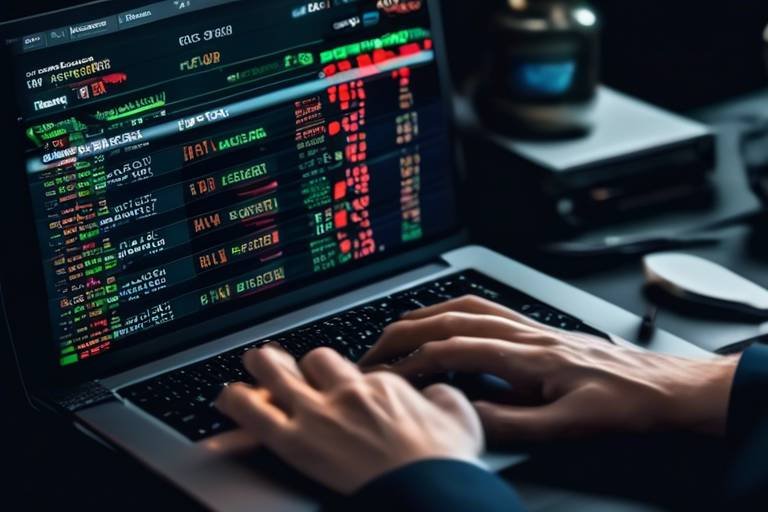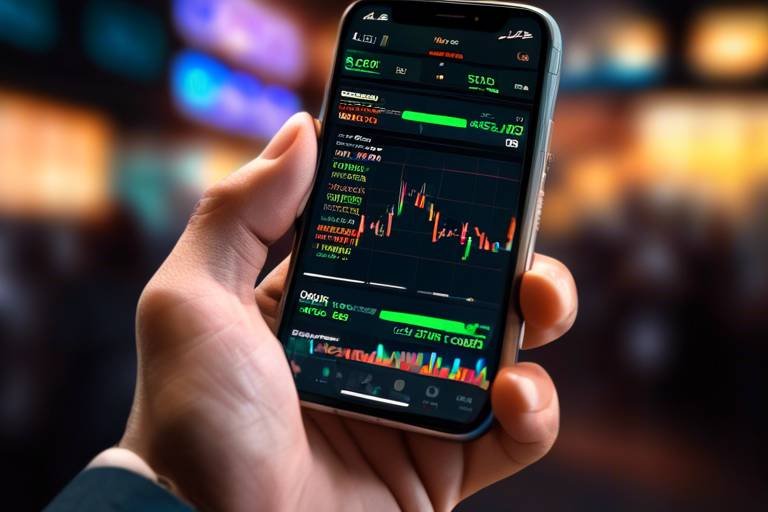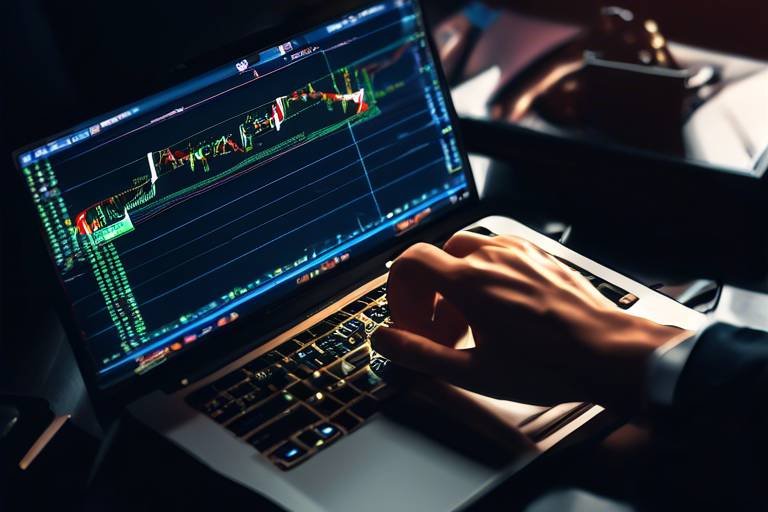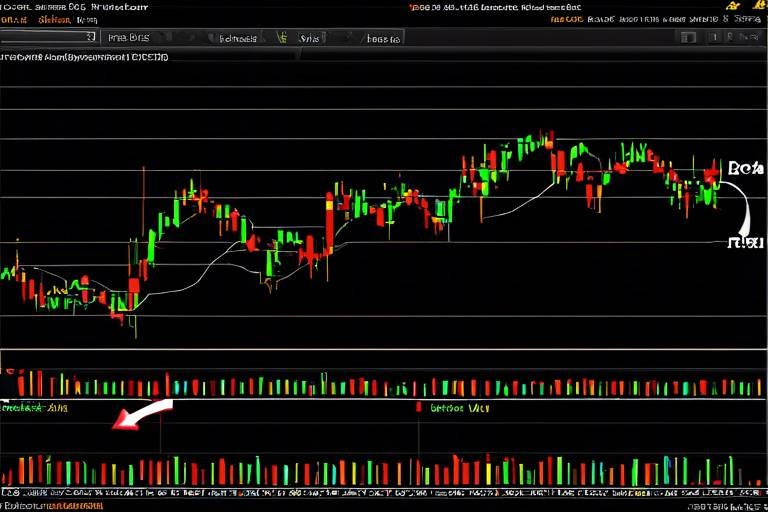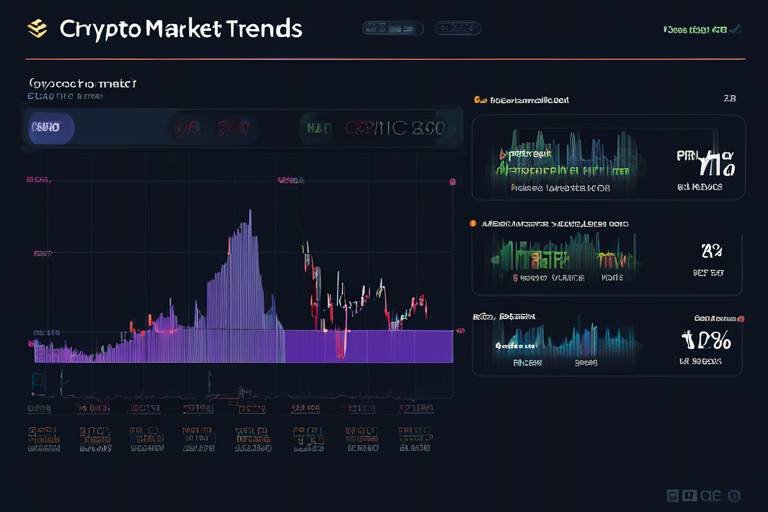How to Set Up Alerts for Crypto Trading
In the fast-paced world of cryptocurrency trading, staying ahead of the curve is crucial for maximizing your investments. Setting up alerts can be a game-changer, acting as your personal assistant that keeps you informed about market changes, price movements, and significant news. Imagine being able to respond to market shifts as they happen, rather than finding out too late. This proactive approach can help you capitalize on opportunities and minimize potential losses.
So, how do you set up these alerts effectively? The process is not as daunting as it may seem. First, you need to understand what crypto alerts are and how they can enhance your trading strategy. Crypto alerts are notifications that inform you of significant market movements. They can be set up based on various parameters, such as price thresholds, percentage changes, or even breaking news that could impact your trades. By utilizing these alerts, you can make informed decisions and act quickly in a market that can change in the blink of an eye.
Choosing the right platform is also essential in this process. Different trading platforms offer various features and functionalities, which can significantly affect how you set up and receive alerts. For instance, some may provide more customizable options, while others might focus on advanced analytics. Understanding these differences will help you select a platform that aligns with your trading needs and preferences.
Once you've chosen a platform, setting up alerts is typically a straightforward process. You'll need to configure parameters that matter most to you. This could involve specifying a particular price point for a cryptocurrency or setting up alerts for significant percentage changes. By tailoring these parameters to fit your trading style, you can ensure that you receive relevant notifications that prompt timely actions.
In the following sections, we will explore the types of alerts you can set up, best practices for their implementation, and how to avoid common pitfalls such as alert fatigue. By the end of this article, you'll be equipped with the knowledge to set up alerts that enhance your trading experience and help you navigate the exciting world of cryptocurrency trading with confidence.
- What are crypto alerts? Crypto alerts are notifications that inform traders about significant market movements, allowing them to make timely decisions.
- How do I set up alerts on a trading platform? Setting up alerts usually involves selecting parameters such as price thresholds or percentage changes within your chosen trading platform.
- Can I customize my alerts? Yes, most trading platforms allow you to customize alerts based on your trading preferences and strategies.
- What should I do if I experience alert fatigue? To avoid alert fatigue, consider adjusting the frequency and relevance of your alerts to ensure they remain effective and actionable.

Understanding Crypto Alerts
In the fast-paced world of cryptocurrency trading, timeliness can make or break your investment strategy. This is where crypto alerts come into play. Crypto alerts are essentially notifications that inform traders about significant market movements, such as price changes, volume spikes, or important news events. Think of them as your personal market watchdogs, tirelessly monitoring the ever-changing landscape of cryptocurrency so you don’t have to. By understanding how these alerts function, you can enhance your trading strategies and make informed decisions that could lead to better profits.
The beauty of crypto alerts lies in their customization. Traders can set alerts based on specific criteria that matter most to them. For instance, you might want to be notified when Bitcoin hits a certain price point or when Ethereum's trading volume exceeds a set threshold. This level of personalization allows you to focus on what’s relevant to your trading style, making it easier to react swiftly to market changes.
There are various types of alerts available, each serving a different purpose. Here’s a brief overview of some common alert types:
- Price Alerts: Notify you when a cryptocurrency reaches a specific price.
- Volume Alerts: Inform you when trading volume surpasses a certain level.
- News Alerts: Keep you updated on major news events that could affect the market.
By utilizing these alerts effectively, you can stay ahead of the curve. Imagine you’re on a road trip, and suddenly the GPS alerts you to a traffic jam ahead. You can take an alternative route, saving you time and frustration. Similarly, crypto alerts allow you to navigate the complexities of the crypto market, enabling you to capitalize on opportunities while avoiding potential pitfalls.
However, it's essential to strike a balance. Too many alerts can lead to what’s known as alert fatigue, where you become desensitized to notifications, potentially missing out on critical information. Therefore, it’s crucial to fine-tune your alert settings to ensure they provide value without overwhelming you. In the following sections, we’ll delve deeper into how to set up these alerts effectively and explore the best practices to maximize their utility.

Choosing the Right Platform
When it comes to crypto trading, selecting the right platform can feel like finding a needle in a haystack. With so many options available, how do you know which one is the perfect fit for your trading style? It’s not just about picking a platform that looks good; it’s about finding one that meets your specific needs and enhances your trading experience. You wouldn’t wear shoes that are too big or too small, right? The same logic applies to trading platforms. You want a platform that fits just right!
First and foremost, consider the features that each platform offers. Some platforms are designed with beginners in mind, providing intuitive interfaces and easy navigation. Others cater to seasoned traders with advanced tools and analytics. Think about what you need: Are you looking for basic trading capabilities, or do you require sophisticated charting tools and real-time data? The right platform should align with your trading goals and provide the tools necessary for success.
Additionally, take a closer look at the fees associated with each platform. Trading fees can eat into your profits faster than you think! Some platforms charge a flat fee per trade, while others might take a percentage of your transaction. It’s essential to read the fine print and understand the cost structure. For instance, if you’re a frequent trader, a platform with lower fees could save you a significant amount over time. Here’s a quick comparison of potential fee structures:
| Platform | Fee Structure | Additional Costs |
|---|---|---|
| Platform A | 0.1% per trade | Withdrawal fees apply |
| Platform B | $5 flat fee per trade | No withdrawal fees |
| Platform C | 0.2% per trade | Monthly subscription for advanced features |
Another crucial aspect to consider is user experience. A platform might have all the bells and whistles, but if it’s difficult to navigate, you’ll find yourself frustrated and less likely to make trades. Look for user reviews and testimonials to gauge the overall satisfaction of other traders. You want a platform that not only works well but also feels intuitive and comfortable to use.
Lastly, don’t forget about customer support. In the fast-paced world of crypto trading, having access to reliable support can make all the difference. Whether you encounter a technical issue or have a question about your account, responsive customer service can help you resolve problems quickly. Check if the platform offers multiple support channels, such as live chat, email, or phone support. After all, in the world of trading, every second counts!
In conclusion, choosing the right platform is a vital step in your crypto trading journey. By considering the features, fees, user experience, and customer support, you can make an informed decision that sets you up for success. Remember, the right platform can empower you to trade with confidence and seize opportunities as they arise!
Q: What should I prioritize when choosing a trading platform?
A: Focus on features, fees, user experience, and customer support to find the best fit for your trading style.
Q: Are there platforms that cater specifically to beginners?
A: Yes, many platforms offer user-friendly interfaces and educational resources designed for new traders.
Q: How can I minimize trading fees?
A: Look for platforms with lower fee structures or those that offer discounts for high-volume trading.

Comparison of Popular Platforms
When it comes to selecting a trading platform for cryptocurrency, the choices can be overwhelming. Each platform has its unique features, strengths, and weaknesses. To help you navigate through the sea of options, let's dive into a comparison of some of the most popular platforms available today. This comparison will focus on key aspects such as user interface, alert capabilities, fees, and overall user experience. By understanding these factors, you can make a more informed decision that aligns with your trading goals.
First up, we have Platform A. This platform is often praised for its user-friendly interface. It's designed with beginners in mind, making it easy to navigate even if you're new to crypto trading. One standout feature is its customizable alert options, which allow traders to set notifications based on their specific trading strategies. For instance, you can set alerts for price changes or volume spikes, ensuring you never miss a critical market movement. However, while it's great for newcomers, some experienced traders might find it lacking in advanced analytical tools.
On the other hand, Platform B caters to the more seasoned traders out there. Known for its advanced analytics and comprehensive alert capabilities, this platform provides a wealth of tools for market analysis. You can set sophisticated alerts that go beyond simple price points, such as percentage changes or even technical indicators. However, this complexity comes with a steeper learning curve and potentially higher fees. For traders who thrive on data and need in-depth insights, Platform B could be the perfect match.
| Feature | Platform A | Platform B |
|---|---|---|
| User Interface | User-friendly | Complex but powerful |
| Alert Customization | Basic options | Advanced options |
| Fees | Low | Moderate to high |
| Target Audience | Beginners | Experienced traders |
Ultimately, the choice between these platforms comes down to your individual trading style and experience level. If you're just starting out, you might prefer the simplicity of Platform A. However, if you have some experience under your belt and are looking for powerful tools to enhance your trading strategy, Platform B could be worth the investment. Remember, the right platform can significantly influence your trading success, so take your time to explore and find the one that fits you best.
As we wrap up this discussion on setting up alerts for crypto trading, you might still have some lingering questions. Here are a few frequently asked questions that can help clarify your understanding:
- What are crypto alerts? Crypto alerts are notifications that inform traders about significant market movements, helping them make timely decisions.
- How do I set up alerts? Alerts can be set up through your trading platform by configuring parameters such as price thresholds or percentage changes.
- Are alerts effective for all traders? Yes, alerts can be beneficial for traders of all experience levels, but it's important to customize them according to your trading strategy.
- Can I receive alerts on my mobile device? Most modern trading platforms offer mobile apps that allow you to receive alerts directly on your smartphone.

Platform A Overview
Platform A is designed with both beginners and experienced traders in mind, offering a seamless user experience that caters to a wide range of trading styles. One of its standout features is the customizable alert system, which allows users to set personalized notifications based on their specific trading strategies. Imagine being able to tailor your alerts to your unique needs, just like customizing a playlist for your mood—this is what Platform A provides. The interface is not only intuitive but also visually appealing, making it easy for traders to navigate through various options without feeling overwhelmed.
Moreover, Platform A offers a robust set of tools that facilitate effective market analysis. Traders can access real-time data, technical indicators, and historical price charts, which are crucial for making informed decisions. The platform's alert system is particularly beneficial, as it enables users to receive notifications via multiple channels, whether through email, SMS, or in-app alerts. This flexibility ensures that traders never miss a critical market movement.
Another significant advantage of Platform A is its community support. Users can engage with fellow traders through forums and discussion groups, sharing insights and strategies that can enhance their trading experience. This sense of community can be invaluable, especially for newcomers who might feel isolated in their trading journey. Additionally, the platform frequently updates its features based on user feedback, ensuring that it remains relevant in the fast-paced world of cryptocurrency trading.
In terms of security, Platform A employs industry-standard measures to protect user data and funds. With features like two-factor authentication and encryption protocols, traders can feel confident that their investments are safe. The combination of these features makes Platform A a compelling choice for anyone looking to dive into the world of cryptocurrency trading.

Platform B Overview
Platform B stands out in the crowded field of cryptocurrency trading platforms, primarily due to its advanced analytics and comprehensive alert capabilities. Designed with professional traders in mind, it offers a suite of tools that allow for in-depth market analysis, enabling users to make informed decisions swiftly. One of the key features that sets Platform B apart is its ability to provide real-time data and insights, which can be critical during volatile market conditions.
Traders using Platform B can benefit from a variety of alert types, ensuring they never miss a significant market movement. For instance, price alerts can be set to notify users when a cryptocurrency hits a predetermined price, allowing for timely execution of trades. Additionally, volume alerts can be configured to inform traders when trading volumes surge or drop, which often indicates potential market shifts.
Moreover, the platform offers customizable dashboards where users can track multiple cryptocurrencies simultaneously. This feature is particularly useful for those managing diverse portfolios, as it allows for quick assessments of market performance across different assets. The intuitive interface makes it easy to navigate, even for those who may not be tech-savvy.
Another aspect worth mentioning is the community support that Platform B provides. Users have access to forums and discussion boards where they can exchange insights and strategies with fellow traders. This collaborative environment fosters a learning culture and helps traders stay updated on the latest market trends and trading techniques.
In summary, if you are a professional trader seeking a platform that offers powerful analytics, customizable alerts, and a supportive community, Platform B could be the ideal choice for you. Its robust features are designed to enhance trading efficiency and effectiveness, making it a valuable tool in the ever-evolving cryptocurrency landscape.

Setting Up Alerts
This article explores the essential steps to set up alerts for cryptocurrency trading, helping traders stay informed about market changes and make timely decisions to maximize their investments.
Crypto alerts are notifications that inform traders about significant market movements. Understanding how these alerts work can enhance trading strategies and improve decision-making processes.
Selecting the right trading platform is crucial for effective alert setup. Different platforms offer various features, so it's important to choose one that aligns with your trading needs.
A comparison of popular trading platforms can help you determine which one suits your requirements best. Features, fees, and user experiences should all be considered.
Platform A offers a user-friendly interface and customizable alert options, making it suitable for both beginners and experienced traders looking for flexibility in their trading approach.
Platform B is known for its advanced analytics and alert capabilities. It caters to professional traders who require comprehensive tools for market analysis and decision-making.
Setting up alerts for cryptocurrency trading is not just a technical process; it's an art that can significantly enhance your trading experience. To begin, you need to navigate to the alerts section of your chosen trading platform. Here, you'll typically find options to customize your alerts based on various parameters.
First, consider what type of alerts you want to set. Do you want to be notified when the price of Bitcoin hits a certain threshold, or perhaps when there's a sudden spike in trading volume? Each platform may have different terminology, but the core options usually include:
- Price Alerts: Notify you when a cryptocurrency reaches a specific price.
- Volume Alerts: Inform you when trading volume exceeds a set amount.
- News Alerts: Keep you updated on significant market news that could affect your trades.
After determining the type of alerts, you will need to configure the parameters. This involves setting specific values that trigger the alerts. For example, if you're setting a price alert for Ethereum, you might want to set it at a price that is slightly above the current market value to catch potential upward movements. Be sure to think strategically; setting the alert too close to the current price might result in frequent notifications that could lead to alert fatigue.
Next, many platforms allow you to choose how you receive these alerts. Options usually include:
- Email notifications
- SMS alerts
- In-app notifications
Choosing the right notification method is essential. If you’re often away from your computer, SMS alerts might be the best choice to ensure you’re always updated. However, if you prefer a more detailed overview, email notifications can provide more context.
Once you've set your alerts, it's important to monitor their effectiveness. Are they helping you make timely decisions? If you find that you're receiving too many alerts or not enough, don't hesitate to go back and adjust your settings. Remember, the goal is to enhance your trading strategy, not to overwhelm yourself with notifications.
In conclusion, setting up alerts is a straightforward process, but it requires careful consideration of your trading goals and preferences. By customizing your alerts effectively, you can stay ahead in the fast-paced world of cryptocurrency trading.
There are various types of alerts traders can set up, including price alerts, volume alerts, and news alerts. Understanding these types can help tailor your trading strategy effectively.
Price alerts notify traders when a cryptocurrency reaches a specific price point. This feature is essential for executing trades at optimal times to maximize profits.
News alerts keep traders informed about significant developments that could impact market trends. Staying updated on news can provide a competitive edge in trading decisions.
Implementing best practices for setting alerts can enhance their effectiveness. This includes choosing appropriate thresholds and avoiding alert fatigue to ensure timely responses.
Selecting the right thresholds for alerts is critical. Setting them too high or too low can lead to missed opportunities or unnecessary notifications.
Alert fatigue occurs when traders receive too many notifications, leading to desensitization. Balancing alert frequency and relevance is key to maintaining effective trading strategies.
Q: How do I choose the right alert settings?
A: Consider your trading goals, the cryptocurrencies you're interested in, and how often you want to be notified. Start with broader alerts and refine them as you gain experience.
Q: Can I set multiple alerts for the same cryptocurrency?
A: Yes, most platforms allow you to set multiple alerts for different parameters, such as price points and volume changes.
Q: What should I do if I receive too many alerts?
A: Revisit your alert settings and adjust the parameters or frequency to reduce the number of notifications you receive.

Types of Alerts
When diving into the world of cryptocurrency trading, understanding the different types of alerts available is crucial for any trader looking to make informed decisions. Alerts act like your personal market watchdog, notifying you of significant changes or events that could impact your investments. By leveraging these alerts, you can tailor your trading strategy to respond swiftly to market dynamics. Let's break down the primary types of alerts you can set up:
Price Alerts are perhaps the most common type of alert traders utilize. Imagine you have your eye on a cryptocurrency, and you're waiting for it to hit a specific price point before you make your move. Price alerts notify you when a cryptocurrency reaches that predetermined price, allowing you to execute trades at optimal times. This is particularly useful in the volatile crypto market, where prices can fluctuate wildly within minutes. For instance, if you set a price alert for Bitcoin at $30,000, you'll receive a notification as soon as it hits that mark, ensuring you never miss an opportunity to buy or sell.
Another important type of alert is Volume Alerts. These alerts notify you when there is a significant change in trading volume for a particular cryptocurrency. Why does this matter? Well, high trading volume can indicate strong interest in a coin, often leading to price movements. If you see a sudden spike in volume, it might be a signal to investigate further or act quickly. For example, if a coin you’re tracking suddenly sees a volume increase of 50% in an hour, a volume alert will ensure you're aware of this shift, potentially guiding your trading decisions.
Then we have News Alerts, which are vital for keeping you informed about the latest developments in the crypto world. These alerts can be set up to notify you about significant news events, regulatory changes, or technological advancements related to the cryptocurrencies you are trading. Staying updated on news can provide you with a competitive edge, as market reactions to news can be swift and dramatic. For instance, if a major exchange announces they will start supporting a new cryptocurrency, a news alert will help you capitalize on the potential price surge that may follow.
To summarize, here are the main types of alerts you should consider:
- Price Alerts: Notify you when a cryptocurrency reaches a specific price.
- Volume Alerts: Inform you of significant changes in trading volume.
- News Alerts: Keep you updated on important news that could impact market trends.
Understanding these types of alerts is just the beginning. The real magic happens when you combine them effectively to create a robust trading strategy. By setting up a mix of price, volume, and news alerts, you can ensure that you are always in the loop, ready to make informed decisions that could lead to significant profits in the fast-paced world of cryptocurrency trading.

Price Alerts
Price alerts are like your personal trading assistants, whispering in your ear whenever a cryptocurrency reaches a specific price point. Imagine you're a chef waiting for the perfect moment to take your soufflé out of the oven; you wouldn't want to miss that critical moment, right? Similarly, price alerts ensure that you never miss an opportunity to buy low or sell high. They can be set up to notify you via text, email, or even through an app notification, depending on the platform you choose. This way, you can stay on top of the market without having to constantly monitor your screen.
Setting up price alerts is straightforward, but it requires a bit of strategy. You need to decide on the price thresholds that are significant for your trading goals. For instance, if you’re eyeing a cryptocurrency that’s currently priced at $100, you might want to set alerts for when it drops to $90 or spikes to $110. This enables you to react quickly to market movements. Here’s a quick example of how you might set your thresholds:
| Cryptocurrency | Current Price | Alert Price (Buy) | Alert Price (Sell) |
|---|---|---|---|
| Bitcoin (BTC) | $30,000 | $28,000 | $32,000 |
| Ethereum (ETH) | $2,000 | $1,800 | $2,200 |
By setting these alerts, you can maximize your chances of making profitable trades. However, it’s essential to remember that price alerts are just one piece of the trading puzzle. They should be combined with other tools and analyses, such as market trends and news updates, for a more comprehensive trading strategy. Additionally, you should consider the timing of your alerts. For example, if you’re trading a highly volatile asset, you might want to set tighter thresholds to capture rapid price movements.
In conclusion, price alerts are a powerful tool for any cryptocurrency trader. They not only help you stay informed but also empower you to make timely decisions that can significantly impact your trading success. Just like a well-timed alarm can wake you up for an important meeting, price alerts can wake you up to lucrative trading opportunities!
- What are price alerts? Price alerts are notifications that inform traders when a cryptocurrency reaches a specified price point.
- How do I set up price alerts? Most trading platforms allow you to set up price alerts in the settings menu. You can specify the cryptocurrency and the price levels you want to be alerted about.
- Can I receive alerts via SMS? Yes, many platforms offer SMS notifications, email alerts, or app notifications based on your preferences.
- Are price alerts effective for all traders? Yes, price alerts can benefit traders of all experience levels, from beginners to seasoned professionals.

News Alerts
In the fast-paced world of cryptocurrency trading, staying ahead of the game is crucial. One of the most effective ways to do this is by setting up . These alerts keep you informed about significant developments that could impact market trends, allowing you to make timely decisions. Imagine being able to react instantly to a major announcement, like a regulatory change or a partnership between a crypto project and a well-known company. This kind of information can send prices soaring or plummeting, and having a news alert can mean the difference between a missed opportunity and a profitable trade.
So, how do news alerts work? Most trading platforms allow you to customize your alerts based on specific keywords, sources, or topics. For instance, you can set alerts for news related to Bitcoin, Ethereum, or any other cryptocurrency you're interested in. This means you won't have to sift through countless articles; you'll receive notifications that matter to your trading strategy. You can think of it as having a personal assistant who filters out the noise and delivers only the most relevant information right to your inbox or mobile device.
Here’s a quick overview of what to consider when setting up your news alerts:
- Source Reliability: Always choose trustworthy news sources. Look for established financial news outlets or specialized crypto news platforms.
- Keyword Relevance: Use specific keywords that align with your trading interests. This ensures you receive alerts that are pertinent to your strategy.
- Frequency: Determine how often you want to receive alerts. Too many notifications can lead to alert fatigue, making it easy to overlook crucial updates.
Moreover, integrating news alerts with your trading platform can enhance your overall trading experience. Many platforms allow you to link your alerts directly to your trading dashboard, enabling you to act swiftly on the information received. For example, if a news alert notifies you of a partnership announcement that could boost a cryptocurrency’s value, you can quickly analyze the situation and decide whether to buy or sell. This seamless integration between news and trading can give you a competitive edge, ensuring you’re always in the loop.
In conclusion, setting up news alerts is not just a good idea; it's a vital part of a successful trading strategy. By staying informed about the latest developments, you can make more educated decisions, mitigate risks, and ultimately enhance your trading performance. The crypto market is unpredictable, but with the right tools and information, you can navigate it more effectively. So, don’t wait—set up your news alerts today and start trading smarter!
- What are news alerts? News alerts are notifications that inform traders about significant developments in the cryptocurrency market that could impact prices.
- How do I set up news alerts? You can set up news alerts through your trading platform by selecting specific keywords or topics related to cryptocurrencies.
- Why are news alerts important? They help traders stay informed and make timely decisions, potentially leading to better trading outcomes.
- Can I customize my news alerts? Yes, most platforms allow you to customize your alerts based on sources, keywords, and frequency.

Best Practices for Alerts
When it comes to setting up alerts for crypto trading, implementing best practices can make all the difference between seizing a golden opportunity and letting it slip through your fingers. Imagine you're a fisherman, and the alerts are your nets. If your nets are too wide, you'll catch everything, but you might miss the big fish you're really after. Conversely, if they're too narrow, you might let the best catches escape. Therefore, it’s essential to find the right balance.
One of the first things to consider is threshold selection. Setting the right price points for your alerts is crucial. If you set your alerts too high, you might miss out on significant price movements. On the flip side, if your thresholds are too low, you could be bombarded with notifications that lead to confusion and missed opportunities. A smart approach is to analyze historical price data and set your alerts based on realistic market behaviors. For instance, if Bitcoin has historically fluctuated within a certain range, it makes sense to set alerts just outside of that range to catch any significant shifts.
Another critical aspect is avoiding alert fatigue. This phenomenon occurs when traders receive an overwhelming number of notifications, causing them to become desensitized. It’s like the boy who cried wolf; after a while, the alerts lose their urgency. To combat this, consider the following strategies:
- Limit the number of alerts you set up to only the most crucial ones.
- Customize alerts based on your trading strategy and risk tolerance.
- Regularly review and adjust your alert settings based on market conditions.
Additionally, integrating news alerts into your strategy can provide a competitive edge. Staying informed about the latest developments in the crypto space allows you to react swiftly to market changes. However, it's essential to filter news sources and focus on reliable outlets to avoid misinformation, which can lead to poor trading decisions. Think of it as curating your own newsfeed; you want to ensure that the information you receive adds value to your trading strategy.
Lastly, consider using a trading journal to track your alerts and their outcomes. Documenting your trades, the alerts that prompted them, and the results can help you refine your strategy over time. It’s like having a map that guides you through the turbulent waters of crypto trading. By analyzing your successes and failures, you can adjust your alert settings and improve your overall trading performance.
Q1: What are crypto alerts?
Crypto alerts are notifications that inform traders about significant market movements, such as price changes or news events, allowing them to make timely trading decisions.
Q2: How often should I set alerts?
The frequency of alerts should be based on your trading strategy and risk tolerance. It's important to avoid alert fatigue by limiting the number of notifications to only the most crucial ones.
Q3: Can I set alerts for multiple cryptocurrencies?
Yes, most trading platforms allow you to set alerts for multiple cryptocurrencies, enabling you to monitor various assets simultaneously.
Q4: What types of alerts can I set up?
You can set up various types of alerts, including price alerts, volume alerts, and news alerts, to tailor your trading strategy effectively.
Q5: How can I avoid missing important alerts?
To avoid missing important alerts, set appropriate thresholds based on historical data, customize alerts for significant price movements, and ensure you stay updated on relevant news.

Threshold Selection
When it comes to setting up alerts for crypto trading, plays a pivotal role in your overall strategy. Imagine you're a hunter, waiting patiently for the perfect moment to strike. If your threshold is set too high, you might miss the opportunity to catch that elusive prey. Conversely, if it's too low, you could find yourself overwhelmed with alerts that don't warrant your attention. The key is to find that sweet spot that aligns with your trading goals.
To begin with, consider your trading style. Are you a day trader who thrives on quick trades and rapid movements, or are you a long-term investor who prefers to hold onto assets for a while? Each approach requires different thresholds. For day traders, setting tighter price alerts can help them capitalize on small fluctuations, while long-term investors might focus on broader trends and set alerts for more significant price changes.
Next, think about the volatility of the cryptocurrencies you are trading. Some coins experience wild price swings, while others are more stable. For highly volatile assets, a wider threshold might prevent you from being bombarded with alerts every time the price shifts. On the other hand, for more stable currencies, a narrower threshold could be beneficial to catch those rare, profitable moments.
Another factor to consider is the time frame of your alerts. Are you looking for immediate notifications, or can you afford to wait for a daily summary? Setting alerts for different time frames can help you manage your trading strategy effectively. For instance, you might want to set an alert for immediate price drops but also receive a daily summary of price changes to inform your longer-term decisions.
Finally, it’s crucial to regularly review and adjust your thresholds. The crypto market is ever-changing, and what worked last month may not be effective today. By continually assessing your alert settings, you can ensure that they remain relevant and aligned with your trading strategy. This ongoing adjustment is akin to tuning a musical instrument; a slight tweak can make all the difference in achieving harmony in your trading approach.
In conclusion, effective threshold selection is about finding a balance that suits your trading style, the volatility of the assets, and your personal preferences. Take the time to experiment with different settings, and don’t hesitate to make adjustments as needed. After all, in the fast-paced world of cryptocurrency trading, being proactive can lead to significant rewards.
- What is the best way to set price thresholds? It's best to start with a range based on historical price movements and adjust as necessary based on market trends.
- How often should I review my alert thresholds? Regular reviews, ideally every month or after significant market changes, can help keep your strategy effective.
- Can I set multiple alerts for the same cryptocurrency? Yes, setting multiple alerts for different thresholds can help you stay informed about various price points.

Avoiding Alert Fatigue
In the fast-paced world of cryptocurrency trading, alert fatigue can be a trader's worst enemy. Imagine this: you’re sitting at your desk, eagerly waiting for that perfect moment to strike, and then—ping! Your phone buzzes with yet another alert. At first, it’s exciting, but after a while, those notifications turn into a cacophony of distractions. You start ignoring them, and before you know it, you’ve missed a crucial market shift. So, how do you avoid this pitfall and keep your trading strategy sharp?
The key to avoiding alert fatigue lies in balancing frequency and relevance. You don’t want to be bombarded with notifications for every minor price fluctuation. Instead, focus on setting alerts that matter to you and your trading goals. For instance, if you’re primarily interested in significant price movements, consider configuring alerts for price changes that exceed a certain percentage or for specific price points. This way, you’ll receive notifications that are meaningful and actionable, rather than a constant stream of noise.
Another effective strategy is to categorize your alerts based on their importance. You can create a system where you differentiate between high-priority alerts, like major price changes or news events, and low-priority ones, such as minor fluctuations. By doing this, you can ensure that your attention is directed towards the most critical updates while filtering out the less significant ones. Here’s a simple table to illustrate how you might categorize your alerts:
| Alert Type | Priority Level | Frequency |
|---|---|---|
| Major Price Movement | High | Immediate |
| News Updates | Medium | Daily |
| Minor Price Fluctuation | Low | Weekly |
By implementing a structured approach to your alerts, you can significantly reduce the chances of alert fatigue. Furthermore, it’s essential to regularly review and adjust your alert settings. As your trading strategy evolves, so too should your alert preferences. Perhaps you initially set up alerts that were relevant, but over time, your focus has shifted. Periodically reassessing your alert configurations will ensure they continue to serve your trading needs effectively.
Finally, consider utilizing alert management tools offered by many trading platforms. These tools often come with features that allow you to customize how and when you receive notifications. For example, you can opt for email alerts instead of push notifications on your phone, which might help in reducing the feeling of being overwhelmed. Remember, in the world of trading, less can often be more. By being selective about your alerts, you can maintain your focus and make informed decisions without the constant interruption of unnecessary notifications.
Frequently Asked Questions
- What are crypto alerts and why are they important?
Crypto alerts are notifications that inform traders about significant market movements, such as price changes, volume spikes, or important news events. They are crucial for making timely trading decisions, allowing traders to capitalize on market opportunities and manage risks effectively.
- How do I choose the right platform for setting up alerts?
Choosing the right platform involves evaluating features, fees, and user experiences. Look for platforms that offer customizable alert options, user-friendly interfaces, and advanced analytics to suit your trading style and needs.
- What types of alerts can I set up?
You can set up various types of alerts, including price alerts, which notify you when a cryptocurrency reaches a specific price point, volume alerts for significant trading activity, and news alerts that keep you updated on market-moving events.
- How do I set up price alerts effectively?
To set up price alerts effectively, determine the price thresholds that are meaningful for your trading strategy. Avoid setting them too high or too low to prevent missing opportunities or receiving excessive notifications.
- What is alert fatigue and how can I avoid it?
Alert fatigue occurs when traders receive too many notifications, leading to desensitization and potential missed opportunities. To avoid it, balance the frequency and relevance of your alerts by setting specific thresholds and only receiving notifications that matter to your trading strategy.

